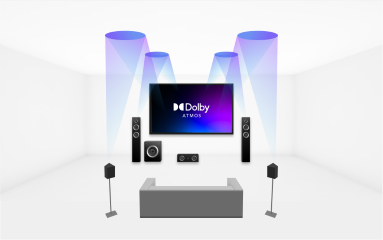
Dolby Atmos® adds the flexibility and power of dynamic audio objects into traditional channel-based workflows. These audio objects allow content creators to control discrete sound elements irrespective of specific playback speaker configurations, including overhead speakers. The foundation of Dolby Atmos is based on two types of audio objects, static and dynamic. Static objects are commonly referred to as "bed objects" as they are defined as non-moving objects that are mapped to specific speaker locations. Typically, this is a 7.1.2 or 7.1.4 layout and is referred to simply as "the bed", which corresponds to traditional non-Atmos configurations like 7.1 and 5.1. Dynamic objects are audio objects that can freely move around the entirety of the listening field. The bed is essential because it provides a format that is still applicable for audio that works best in a channel based environment. Diffuse elements such as ambience, reverb, or anything else that doesn't need to dynamically move around the room would be panned to the bed. Additionally, content that was used in a dynamic object can be folded down into the bed when needed, based on prioritization and object management.
Dynamic objects are used for precise positioning and/or free movement of content within the listening space. One of the most immediate features of Dolby Atmos is the ability to represent sound on the Z axis, both above and below the listener. This doesn’t just allow for a height plane, it actually unlocks the ability for sound to be reproduced in its full three-dimensional glory. One can take some first steps and place sounds in zones along the listener’s perimeter, such as front, side, back, and above. This is appropriate for most content and can create extremely immersive and compelling experiences. The next steps would be to approach design from a layered approach and include concepts such as depth, frequency, proximity, perspective into creation of individual assets as well as the scene as a whole.
An example city environment can be used to demonstrate the use of these concepts when designing a sonic environment. To create the feel of being on the street level of a busy downtown city, the first thing to consider would be the spatial layers. Along the X and Y axes are sound sources that are on the ground level; vehicles in the street, pedestrians on the sidewalk, door sounds and music coming from shops, etc. One could bake all of these elements into a fixed-channel bed, or one could place these sources individually at their relative locations, either in the game engine or the audio engine, in order to build depth and perspective at the listener level. Taking the Z access into account, in this scenario most of the sound that would be coming from above the listener would be reflections and reverb of the street, getting bounced back from the sides of the buildings. One could add some point-source sounds of apartment life coming from some windows, pigeons cooing and flapping their wings, a distant jet passing overhead, etc. The reflections of the street sounds are diffuse and add “air” to what’s happening on the horizontal plane, and the individual spot sounds add detail and variation, plus stratification when placing sources at near, middle, and far distances relative to the listener.
Let’s not forget about the sonic frequency aspect of our scene. As a general rule of thumb, for vertical proximity low frequency content can be thought of and treated in the same manner as horizontal proximity. That is to say, the closer a sound is to the listener, the more low frequencies you may hear, regardless if it’s up and down, front and back, or side to side. Our ears use primarily mid and high frequency cues to perceive location, especially for the upper hemisphere of our surroundings, so bass frequencies don’t contribute as much to spatial perception. What’s more, not only are low bass frequencies more of a physical body sensation, most home theater setups rely on subwoofers to produce the bass signals, which will lower or “ground” the perception of a sound simply because that’s where the low end of the audio is being reproduced. To take this back to our example scene, if we had a garbage truck driving past the listener position, one could use a high-pass filter to modulate the amount of audible low frequency content based on proximity, whether it was on the same street as the player or a bridge above.
One of the benefits of Dolby Atmos from a mixing perspective is that with the addition of higher spatial resolution plus the height plane, an effectively larger sonic canvas is available. This additional space can be used for anything from exaggerated effects, to subtle spaciousness for mix clarity. While there are no hard and fast rules about how to use these new dimensions, one will quickly realize that the content itself will dictate how extreme or subdued one can be. A mind-bending, multi-perspective, abstract game might take full advantage of dynamic audio objects that are flying all over the place. A cinematic, first-person, period piece may benefit from merely a slight widening of the music and effects positioning for better clarity of the dialog.
